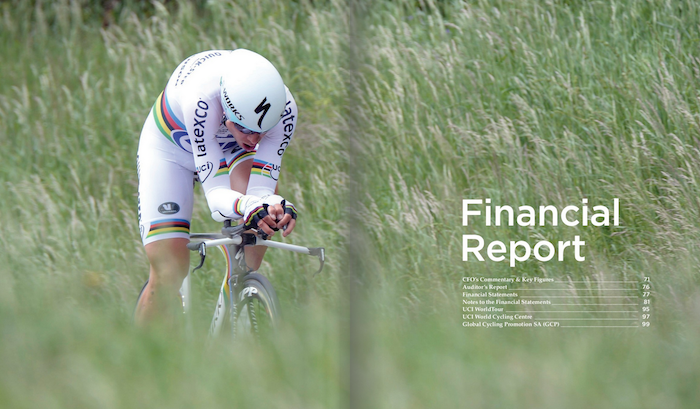
The UCI published their annual report and accounts for 2014 the other day and there was too much going on in the Tour de France to pore over the finances of the governing body. Now it’s worth taking a look to see where things stand.
First up is the new finance director, the wonderfully named Jeremy Conrad-Pickles who forms part of Brian Cookson’s British entourage after a large clear out of staff, including former FD Alain Siegrist. In his annual review there are two noticeable reports:
- The CIRC report cost 2.25 million Swiss Francs (CHF) and was booked in the 2014 accounts
- This tipped the UCI into a loss of CHF 0.95 million for 2014
- The Swiss Franc soared earlier this year while the UCI gets most of its revenues in Euros. This means a sudden rise in costs and a fall in revenues through no fault of the UCI

Revenue for 2014 was CHF 33.4 million, almost identical to the previous year. As the screengrab from the report shows above the UCI gets its money from a variety of sources. Broadcast rights comes from the events it owns and promotes, namely the world championships. Olympic revenues see the International Olympic Committee share out some of its money to governing bodies and the UCI gets a big pot which it spreads out over each year of the Olympic cycle to the tune of CHF 3.1 million a year.
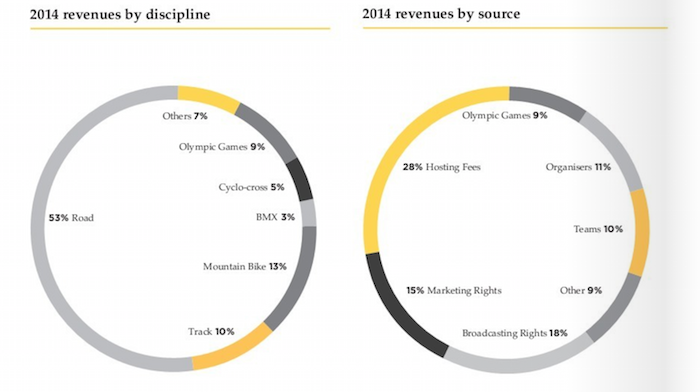
The two charts above show where the money comes from. As you can see road cycling accounts for half of the annual income. It’s easy to associate the UCI with the World Tour, Pro Conti calendars and the top women’s races but of course there is a lot more beyond road cycling. Still road cycling is vital to the UCI and the Ponferrada world championships appear to have brought in CHF 11.3 million, the single largest source of income for the UCI. This sum is split between the hosting fee, TV rights money for the week of racing and sponsorship sales with the hosting fee charged to the organisers the largest of the three ahead of the TV deal. The importance of the Worlds to the UCI’s finances can’t be underestimated.
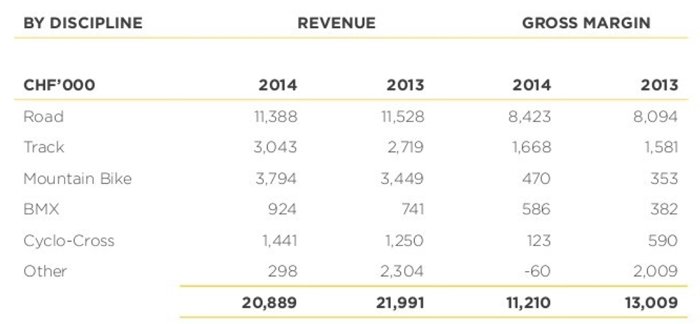
The table above shows the split of the UCI’s organisation activities, for road this is essentially the World Championships. It earned CHF 11.4 million and appears to spend about CHF 3 million on the events leaving it with a tasty CHF 8.4 million. Overall it earns CHF 21 million from competition revenues and ends up with CHF 11.2 million, a margin of over 50%, impressive compared to the 20-25% margin earned by the likes of ASO and RCS.
New for 2014 is the split between “competition” and “governance”, not exactly an exciting revelation but it allows the UCI to distinguish between race-related money and funds for running the sport.
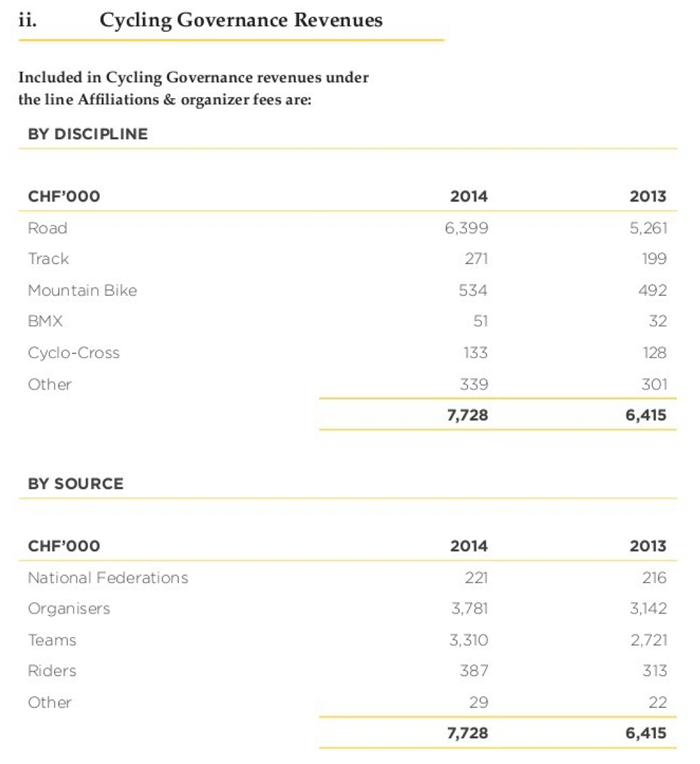
As you can see in the table above road cycling provides most of the governance money. Note the World Tour finances are separate, we’ll come to them in a minute.
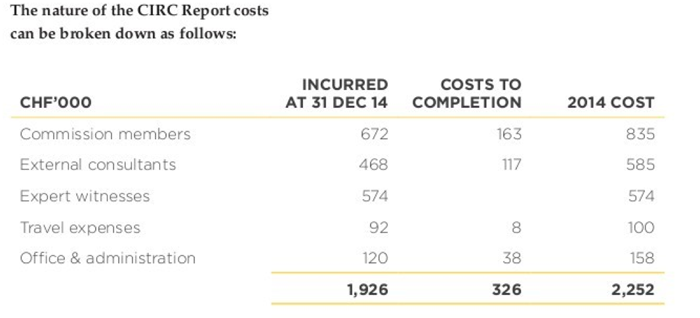
How much did the CIRC cost? CHF 2.25 million. The table above segments the expenditure. Value for money? That’s subjective and the accounts don’t rule on that, you will of course have your own opinion.
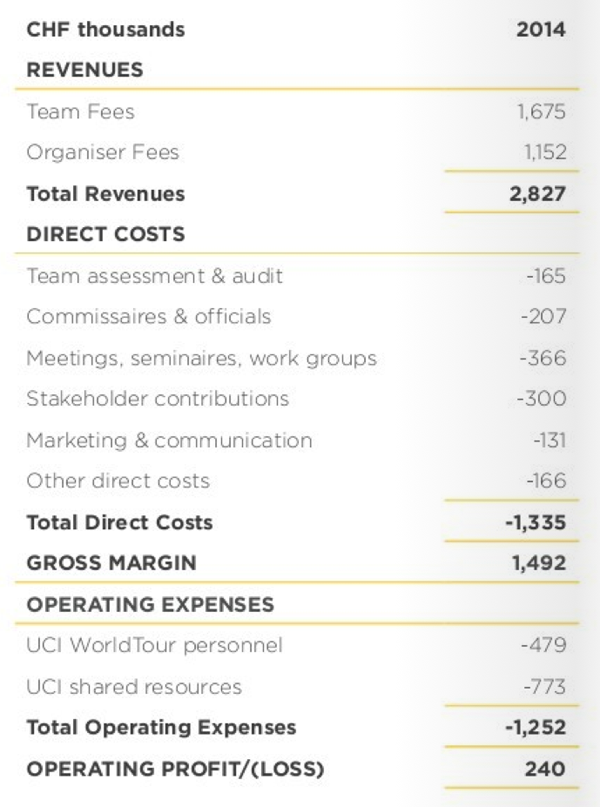
World Tour: During the scandal over Astana’s World Tour licence there are comments floating around that the UCI could not afford to reject the team because of all the money it makes. As the table above shows it collects CHF 1.6 million in fees from teams, divided by 18 that makes CHF 90,000 per team, insignificant compared to the reputational cost of doing the wrong thing. You can see the cost of licencing the teams, a large part of this comes from hiring accounting firm Ernst and Young to review the team budgets.
The UCI is closing down its race promotion arm Global Cycling Promotions. It was supposed to be a money-spinner for the UCI but often ran at loss and the 2014 accounts show more money gone, a loss of CHF 58,000 after the final edition of the Tour of Beijing.
Doping pays: the UCI took CHF 0.9 million in anti-doping fees from rumbled riders, up 300% from the previous year. Answers in the comments if you know who paid this. The UCI pays out CHF 1.1 million a year to the Cycling Anti-Doping Foundation, the “independent” anti-doping body of the UCI… obviously the CADF is dependent on the UCI for funding.
Non profit association: a reminder that the UCI is an “association” under Swiss law which better translates as a charity. This means it has a non-profit status and with it comes tax perks for the governing body and its staff.
Conclusion
Read the full report for yourself if you want to get the full picture of what the UCI did in 2014, this has been a summary look at the money so you don’t have to.
2014 saw a new finance director but similar numbers, the UCI remains a healthy and stable governing body. It has a regular income from the Olympics and the road cycling World Championships are its single largest revenue item and by a long way too. How long until team managers want a slice?
Cycling’s governing body is not changing much on the finance front, its revenues and costs look stable. Having tried to be more entrepreneurial in the past with the Tour of Beijing this activity is stopping. The annual report says World Tour reforms are still on track for 2017 but we’ve not seen much more.
- Exchange rate as of 31 December 2014: 1 CHF = €0.83 = $1 = £0.64

Thank you for taking the trouble to go through the Annual Report and Accounts. Not something that gets me to excited normally !
It is good to see that the UCI appears to have a guaranteed income stream going forward – I am sure teams will take note.
I would also be interested to know which riders were forced to ‘pay up’ for doping infringement’s. Anyone ?
Hope this additional doping penalty continues to increase into the future, making ‘taking the wrong decision’ even more irresponsible.
Whilst there is emphasis on the desire for a clean sport and the independence of the CADF I could not find how much the UCI contributes to CADF. I guess they will produce their own accounts in due course and maybe even remark on whether they think their income is sufficient or not for the testing programme they might wish. I still wonder whether the teams as the historic main contributors all want a full control programme when their budgets are, we are always being told, so tight.
I do see, as promised, the president’s remuneration (344,000).
Interesting that rider fines for doping offences go to the UCI. Would it be better to ‘recycle’ these fines into the CADF pot to incentivise and reward them?
From memory though previous fines have been shared… and I can see what you’re saying but on the other side it means they have an interest in going after a big name because there’s a juicy fine to collect but ignoring a lowly rider who can’t pay so much; they even have an interest in framing someone.
It’s CHF 1.1 million and I’ve edited the above to put the number, partly to set it alongside the income from fines.
It seems that the UCi makes less money in a year than Bayern Munich paid today for a single player (Arturo Vidal). Some teams also seem to have an annual budget close the the UCI’s revenue too.
One wonders where people like Oleg Tinkov see pots of gold coming from because, to me, in terms in international sport, this all seems very small beer.
Or Tom Brady not starting 4 NFL games too the tune of 2 million US$ in lost wages.
“I don’t know how the footballs lost air”
Thanks INRG we have a long way to go to be a cash heavy sport internationally.
I’d like to submit my entry in the “they paid how much for what??!”:
In F1, Ferrari paid Kimi Raikkonnen 50 million dollars NOT to drive for them.
So, who then pays for all the drug testing at events? Or, are all tests run by CADF? If so, 1.1M doesn’t sound like a lot given the amount of races run throughout the year and the amount of riders racing professionally (both men and women).
Maybe a better question is: how is drug testing run and financed and how connected is it to the UCI?
CADF does some testing but there are national federations/national anti-doping agencies and WADA can test too. As to the answer to the question, that’s a big one and probably very hard to get the answer as you’d have to add up agency by agency.
And race organisers pay for testing at their events. And inevitably some of them choose the cheapest option and pay for as little a testing ‘menu’ as possible.
Thanks! It’d be interesting to see the “inner working” of drug testing regimes. I would think that there’s a lot of variation country by country and race by race.
Either the tv companies are exceptional negotiators or there’s just not much money to be had in Road Cycling.
How many major sports are there where the hosting rights of an event bring in 150%+ revenue compared to the worldwide broadcasting rights besides possibly smaller tennis and golf tournaments?
If there is a pot of gold, tv rights are the key and this should make sobering reading.
My understanding is that the race organizers get the money from TV rights, not the UCI – with the one exception of the Worlds.
ASO has a rather conservative attitude, as I understand it, towards TV rights money. They like free to air, and seem to be pretty loyal to broadcasters. Australia’s SBS has kept the broadcast rights to the TDF, for instance, despite not being able to offer much cash for them.
The way I read the second graph along with the financial statement is that it’s 28% revenue from the worlds hosting rights and 18% from the tv rights so it’s got nothing nothing to do with ASO and free to air.
You’re right to say that the UCI don’t get a share of private races tv money but they don’t get a share of hosting rights either so the percentages still stand as far as I can tell. The money the UCI receive from race organisers is shown separately and can be found under Governance Cycling Revenues.
Yes, races own their own TV rights. Note that only some sell them for a decent price and some races pay TV channels like Eurosport to show their races, the idea being that TV coverage showcases sponsors, the region and more so it brings in more sponsors, makes the local region pay more etc. The going rate is €50-80,000 a day to pay Eurosport with all the production costs, helicopters, satellite bandwidth etc.
That might also be a reason for why so many of the commentators are, in the eyes of so many fans, not up to much. Pay peanuts …
Hey, atleast monkeys are not overtly using racist terms unlike an unnamed duo whose names rhymes with tall and till.
What were they saying? (Mercifully, I don’t have to suffer them – one day of those two and I’d forgive Carlton Kirby anything.)
Colored and chinaman
garuda, is it wrong that I laughed?
Last time I had to watch them – couple of years back – Phil sounded like a confused geriatric.
There’s not much money in road cycling.
Time for people to accept this and stop listening to the nonsense of the likes of Velon.
Cap team-spending and you get less inequality between teams.
maybe… maybe not… since salaries are the primary expense for teams, what you propose is essentially a salary cap… and salary caps don’t create “equality”…
i’m not fond of salary caps, i think everyone ahould be able to get paid whatever the team can afford… salary caps artificially deflate the earnings power of the participants… and i want to see guys get paid…
i do agree there isn’t much money in road cycling, especially when compared to “major” sports… how to solve that particular problem, i don’t have concrete answers… i have some ideas… but that is all they are, ideas… i DO know that the sport needs to figure out a way to generate income that isn’t based on sponsors who come and go…
Like you, I don’t know the answers but I do know that the richest sporting clubs in the world wouldn’t be so if the likes of Manchester United were instead called Sharp one year and then Vodafone and then AIG etc etc. I think they currently have over 30 different sponsors that pay to be associated with the club yet how many can you name?
It’s the fans that bring the money. Not just through merchandise but through viewing figures that drive up tv rights that makes these clubs so rich, in terms of revenue at least.
The history of cycling is rich but whereas the teams are normally the ‘anchor’ in other sports, it’s the races in cycling and I don’t think you can sell ‘loyalty’ via say MSR the same way as you can via AC Milan.
yea, i agree…
i had mentioned in another thread that i pay a couple hundred bucks a year to get “nba league pass” so i can watch all the games i want…
IF (big IF) the race organizers stopped running their races as individual fiefdoms, and banded together to offer a similar package for cycling, i would GLADLY pay the same amount of money… i don’t think i’m the only one…
the teams will never make up a “league”…. but the races could, since they are the anchor…
it wouldn’t be easy… a lot of people would have to do a lot of “giving and taking”… but i think something like that could provide at least some type of reliable income stream…
I don’t think cycling particularly needs to make more money – as long as it’s stable – profit should not be the aim: good sport should be.
I like the fact that cycling is quite cheap to watch, rather than having to shell out hundreds a year as one would if one wanted to watch football, for example (in the UK, online: £4 a month for Eurosport; £40 a month for Sky Sports).
I would also say that fandom based on teams is not particularly desirable: it brings few positives and a lot negativity – see the ‘rivalries’ between teams’ supporters in other sports. It makes it less about the actual sport and more about just wanting ‘my team’ to win.
I also like the fact that the races are what cycling is based around – not the teams. This protects the races, makes them the most important thing – and I like that they are separate entities and not some big ‘league’: I like the fact that M-SR is special because it’s M-SR; and is not just another ‘league match’.
The history of cycling is who won which race; not which team was best in 1969.
I don’t think it’s desirable to simplify cycling and make it like other sports. The reason to do this seems to be to attract more viewers: it’s just not that complicated – and it’s not that that stops people watching cycling; the fact is that there just aren’t that many people who are interested in watching people on bikes for three hours (the fools) – most people want instant thrills.
Most of all, I think that cycling fans should not fall into the trap of believing that money is the primary aim. This is what our society teaches us, but it’s certainly not true of sport.
All things in society teach us that if your motivation is money, you don’t get the best ‘thing’, you get the most profitable thing (hence our societies – and our entire lives – are based on money, not happiness).
I’m with you Mr Evans.
I can watch any race with any teams and any riders and enjoy it. I don’t have an affinity to any teams and there’s only a couple of riders I consistently want to win but most of the time my allegiances change to whoever I think is deserving on the day.
My point was entirely in regards to the ramblings of King Oleg and his ilk that to make money, things would need to change significantly.
Let’s hope they don’t and the sport still thrives.
Agreed Larrick – one of the things I really like about cycling: I don’t care who wins or loses (with very few exceptions – that racist CCC bloke, for instance).
Also agreed on Oleg et al.
AIG and Sharp have no problem paying millions to Manchester United. There are very few big corporate sponsors in the pro peloton, the majority of sponsors come from the cycle trade, sugardaddy billonaires and state lotteries. But look at the Tour de France with blue chip sponsors and household brand names like Nestlé, Skoda, Carrefour, Douwe Egberts etc. The difference? Cycling’s legacy of scandals deters many sponsors from backing a team, they’ll sponsor the race not a team. Once teams clean up their acts and can prove to sponsors this has happened, that they’ve got rid of as much risk as possible then the sponsors will come.
The difference being the other big sports were not caught doping for variety of reasons.Lack of testing , better aviodance techniques and my favorite – in Operation Puerto the judge ordered the samples not belonging to cyclists to be destroyed without identification.
other issue is that the race will guarentee exposure where a team does not. Doesn’t matter who is leading the TdF, people will watch and Skoda get their exposure. If Skoda were to sponsor a team, they need that team to do well in order to get the same exposure. One crash or bout of illness and your sponsorship investment is up in smoke.
A salary cap of say 20-25 million euros per team would not stop teams from hiring top riders, but it would stop teams from hoarding loads of top riders. This would be better for the sport because we’d have fewer great riders having their careers stymied (albeit by their own volition) by being used as uber-domestiques and the big teams would be less dominant.
Sure, but a budget cap of $25m is just a cap, most teams earn nowhere near this amount from backers and sponsors making it largely irrelevant.
If you capped Sky’s or BMCs budget at $25m all that money wouldn’t automatically filter out into other teams, the likes of Europcar would still be operating on a shoe-string.
Reducing the cap to an amount that would enforce parity (say $10m a year) would just reverse the prune juice effect meaning less money all around and less money for riders reducing salaries proportionally across the board and I don’t think anyone really wants to see riders paid less. Any serious cap would also be challenged in the courts (as FIFA’s financial fair play rules rare being) because it reduces competition in the jobs market, something against the principles of an open EU.
My question is how could a salary cap be enforced in practice? For example, what would stop the likes of Tinkov paying the likes of Contador extra millions into a Swiss bank account without the UCI knowing?
Could a salary cap ever be practical? I would assume it wouldn’t be.
Or gets paid via a sponsorship route
Always ways of circumventing salary caps
This is one reason why Formula 1 has not yet gone down a cap route. Its impossible to police what large companies do with their money. Imagine, for example, you cap Sky. How do you monitor the outgoings of the whole Murdoch empire (active across several jurisdictions) to establish that Froome or whoever has not been paid a couple of millions on the hush hush? And who is paying for the financial bods who would have to do this work?
As many have already noted, Cycling is small beer in terms of its revenue. It needs to be a streamlined sport, not one that adds costs and complicates the rules.
It would take a lot of work, riders receive salaries but also image rights and bonuses too. As well as what you say there could be straightforward sponsor contracts, eg €1 million in salary but how do you stop someone from earning more in sponsorship and endorsements, a sponsor could pay the rider directly for using their frames / bar tape etc.
There’s also a big difference in tax treatment from country to country, to pay someone a salary of X Euros costs a team a varying sum according to where they are based so it still doesn’t level things out.
It would be incredibly difficult to enforce in a sport that take place in multiple jurisdictions. Especially where most of those jurisdictions are in the EU, where there’s a strong argument that a salary cap would be illegal.
Just be like the UK and “tax” the general public for cycling programs and the UCI takes 10% of the national tax! How much did the UK pay for Olympic cycling development?
Typo: ‘shows aboe’ instead of ‘shows above’
Thanks for your posts as always
So, all that money Vaughters, et al, were up in arms about GCP taking from ‘their’ ProTour licensing payments, turned out to be lost amongst the expenses of a badly-conceived and ultimately unsuccessful venture?
Didn’t the then-UCI management assure the team bosses it would be repaid? Or did that happen already?
The last thing I would want to see is the UCI and race organisers/teams maximising the broadcast rights by selling them to the highest bidder. This would mean more money in the pockets of all parties, including the teams and riders, but it would also mean ads, ads and more ads all throughout the live broadcast. One of the best things about professional road cycling is that you can see it through publicly funded broadcasters in many parts of the world including here in Australia. Alternatively, you may only have access to live broadcasts if you pay a subcription fee and have a decent internet connection.
In addition, more money in the sport has the potential to further increase the differences between the teams in terms of their budget. In fact, can you name any big- money professional team sport where there are not a handful of teams with a much bigger budget than others? Formula 1, football, NBA, they all have seen decreased competition and let’s call it ‘viewing pleasure’ with the obscene amounts of money pouring into these sports.
Many countries in Europe have laws with a list of events that have be shown free and on a mainstream channel. In France this includes the Tour and Paris-Roubaix alongside the Olympics and more. In Italy there’s the Giro, in Belgium there’s De Ronde but also Milan-Sanremo, Lombardia, the Tour and more. Not much use in Australia perhaps but it tends to stop bidding wars for the race rights, if it’s not valuable in France for an audience of 20 million then it won’t be in the US or Australia More info on this at http://inrng.com/2015/02/the-tour-de-frances-tv-guarantee/
+1
There is such a list in Australia, but not surprisingly the Tour is not on it, after all it happens in the middle of the night so audiences will always be small compared to events on the list such as international rugby or the domestic football competitions (rugby league, Australian football). SBS is the lesser funded public broadcaster so has never had much money, so their strategy over many years has been to specialise in football (formerly known as soccer to us) and cycling.
sure in “many parts of the world”, you can… but you can’t in the usa… cable subscription required, and even then, we get very few races…
if there were more ads on msnbc tdf coverage, there wouldn’t be any actual racing…. 🙂 which, to be honest, tells me a lot about the viewing figures without actually seeing them… a zillion “bottom feeder” ads per telecast is a sure sign of “not many viewers”… side note: this is why i dvr them and watch them “sorta live”…
f1, i agree, to a certain extent… f1 has seen decreased competition in the past couple years primarily because of their byzantine “new engine formula” that one manufacturer has figured out better than the rest… ferrari dominated during the schumy years with a LOT of help from their tire manufacturer… red bull dominated during the vettel years because adrian newey is a genius…
speaking as a resident of the usa, american football and nba, nope… the nba has always been dominated by the teams that has “the big gun(s)”, and a team like the knicks who are richer than croesus can’t get out of their own way… american football has never been more popular… both sports have salary caps, fwiw…
i know this is an older blog post, but couldn’t think of where else to put it…
the tour of utah is going on now… despite its slogan (“america’s toughest stage race”, which it is), it is a little fish on the schedule…
they have FREE live streaming of the race from beginning to end… every stage, every day…
if a little fish like the tour of utah, which is based in a country that has a tiny number of cycling “fans”, can figure out a way to do this, it is hard to understand* why other, more prestigious races based in “cycling hotbeds” cannot…
* probably “understand” is the wrong word… i understand why, they are stuck in a world of parochialism and old ways of thinking…
“World Championships are its single largest revenue item and by a long way too. How long until team managers want a slice?”
– Yes, but which teams? – Not the World Tour or Continental teams because they are not the ones that ‘officially’ bring riders to the Road Worlds. The National Governing Bodies are stakeholding members of the UCI, which they want to be cash positive. The NGB staff all love a get together, especially if they have the organising committee paying bed and board so they are willing participants. The riders presumably get a decent payday and home-country fanbase kudos.
It’s the media owners which continue to provide the big money earners, especially TdF, and it’s unlikely the UCI will be able to siphon much out of them. Nor can it emulate their success since the UCI has walked away from the idea of its own race promotions outside the Worlds.
Couple more areas on which numbers could be of interest:
– A comparison of how the money-go-round works for cycling, compared to other sports that have tapped into the financial lifeblood of media.
– How much are the TdF, Giro, Vuelta and the Classics actually worth to their respective organisers in media and promotional revenues?
It was meant tongue-in-cheek but the big teams could say “why I am paying for a rider to go ride in a different jersey” for 1-2 weeks a year. Hopefully they wont but given the worlds has little cultural capital or local roots it is dependent on having star riders so teams might want compensation for their absent riders.
“The importance of the Worlds to the UCI’s finances can’t be underestimated”?
I think it’s even harder to overestimate, though… 😉
My guess is that Menchov paid a big chunk of those money from fines.
“UCI Anti-doping rules:
10.10 Financial Consequences
10.10.1 In addition to the Consequences provided for in Article 10.1-10.9, violation under these Anti-Doping Rules shall be sanctioned with a fine as follows.10.10.1.1 A fine shall be imposed in case a
Rider or other Person exercising a professional activity in cycling is found to have committed an
intentional anti-doping rule violation within the meaning of Article 10.2.3.
The amount of the fine shall be equal to the net annual income from cycling that the Rider or other
Person was entitled to for the whole year in which the anti-doping violation occurred. In the
Event that the anti-doping violation relates to more than one year, the amount of the fine shall be equal to the average of the net annual income from cycling that the Rider or other Person was entitled to during each year covered by the anti-doping rule violation
[Comment: Income from cycling includes the earnings from all the contracts with the Team and the income from image rights, amongst others.]
The net income shall be deemed to be 70 (seventy) % of the corresponding gross income.”
http://www.uci.ch/mm/Document/News/Rulesandregulation/16/85/60/20150101UCIADRPart14-FINAL_English.pdf
JTL was ordered to pay £ 15,400
Hoste, whos cases was closed late 2013, was ordered to pay 150,000 euro
And then there is Barredo, Di Luca, Santambrogio.
Or do they only have to pay the fines when they are returning to pro cycling, as indicated in this article about Bertagnolli: http://www.cyclingnews.com/news/bertagnolli-handed-reduced-ban-by-italian-olympic-committee/